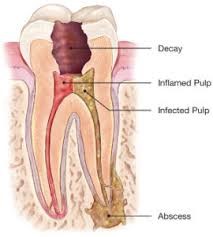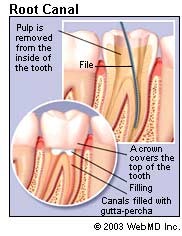Root Canal Therapy
What is a root canal?
Beneath the hard-white enamel shell on the outside of your tooth, there is a soft layer called dentin. On the inside of the soft dentin layer, is the pulp of the tooth, which contains blood vessels and nerve tissue that is vital to the growth of the tooth during formation. Once the tooth is fully formed, it no longer serves a functional purpose as the tooth is provided nourishment by the surrounding tissues after eruption. Its function becomes’ sensory after eruption, to detect heat and cold. Therefore, a non-vital tooth can be a fully functional tooth within the dentition, after a root canal and recommended restoration is completed.

Photo provided by Dentalworks.com
So, if the nerve no longer serves a purpose, why do I need a root canal? What caused the damage?
Endodontic treatment, or a root canal is necessary when the pulp, soft tissue in center of the tooth, becomes infected or inflamed. This inflammation can occur from a variety of reasons including; deep decay, repeated dental procedures on the same tooth, a crack or chip, injury to the tooth (forceful blow to the mouth), and for no reason at all.
 photo provided by aae.org
photo provided by aae.org
Left untreated, a dental abscess (infection) can be a huge problem. An abscess is essentially a pocket of pus that is formed as a result of a bacterial infection in the mouth. This infection, left untreated, can travel to your jaw, neck, brain or cause sepsis, a life-threating infection throughout the body. If the tooth is unable to be saved with a root canal, it must be removed in order to completely remove the infection. Antibiotics will only calm the tooth for a short period and will not cure an abscessed tooth.
What are the signs and symptoms that root canal therapy is needed?
One of the most obvious signs that a root canal is needed is severe pain. It is usually triggered by chewing or the application of pressure. If a tooth has prolonged sensitivity to either heat or cold, lingering after the temperature is removed from the tooth, it also indicates damage to the nerve. If a tooth becomes discolored over time, a bump or small pimple appears close to the root of the tooth. However, sometimes there are no symptoms at all.
The Procedure
Once it is confirmed that a root canal is needed not only from the signs and symptoms, but from a diagnostic radiograph, the dentist will administer local anesthetic. After the tooth and surrounding structures are numb, the dentist will isolate the tooth with a rubber damn. A rubber dam is a small thin sheet of rubber that isolates the tooth and keeps all debris from the patients’ mouth. Using very small instruments, the dentist will remove the carious lesion from the tooth and open the top portion of the canal(s) inside the tooth. Small files will removed the damaged or diseased pulp tissue and begin to shape the canals within the roots. It is likely an irrigation will be used to help irrigate and wash out any residual tissue remaining. Several x-rays may be taken throughout treatment to ensure all tissue is being removed and the canals are properly shaped all the way to the end of the root. If tissue or bacteria is left inside the canal, it is possible for another infection to occur in the future. Once the dentist has completed shaping and irrigating the canals, they will be dried, sealed, and filled with gutta percha,(a plant based material).

Once the root canal is completed, the tooth is no longer vital. It will become more brittle and at risk for fracture if left unprotected. It is recommended that within 7-10 days, the tooth must be permanently restored by placing a full coverage crown over the tooth. The crown will restore the tooth to full function and protect its longevity.